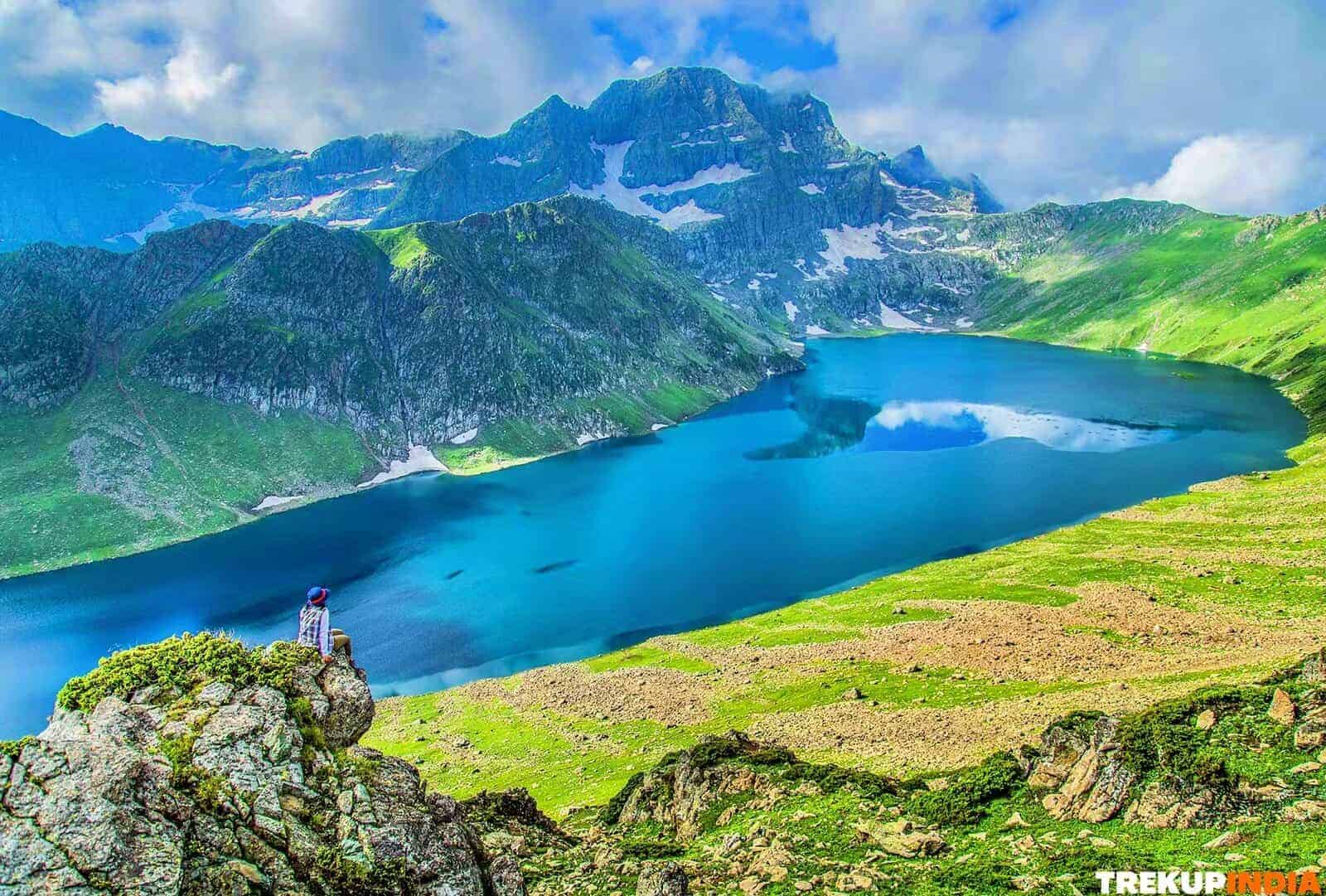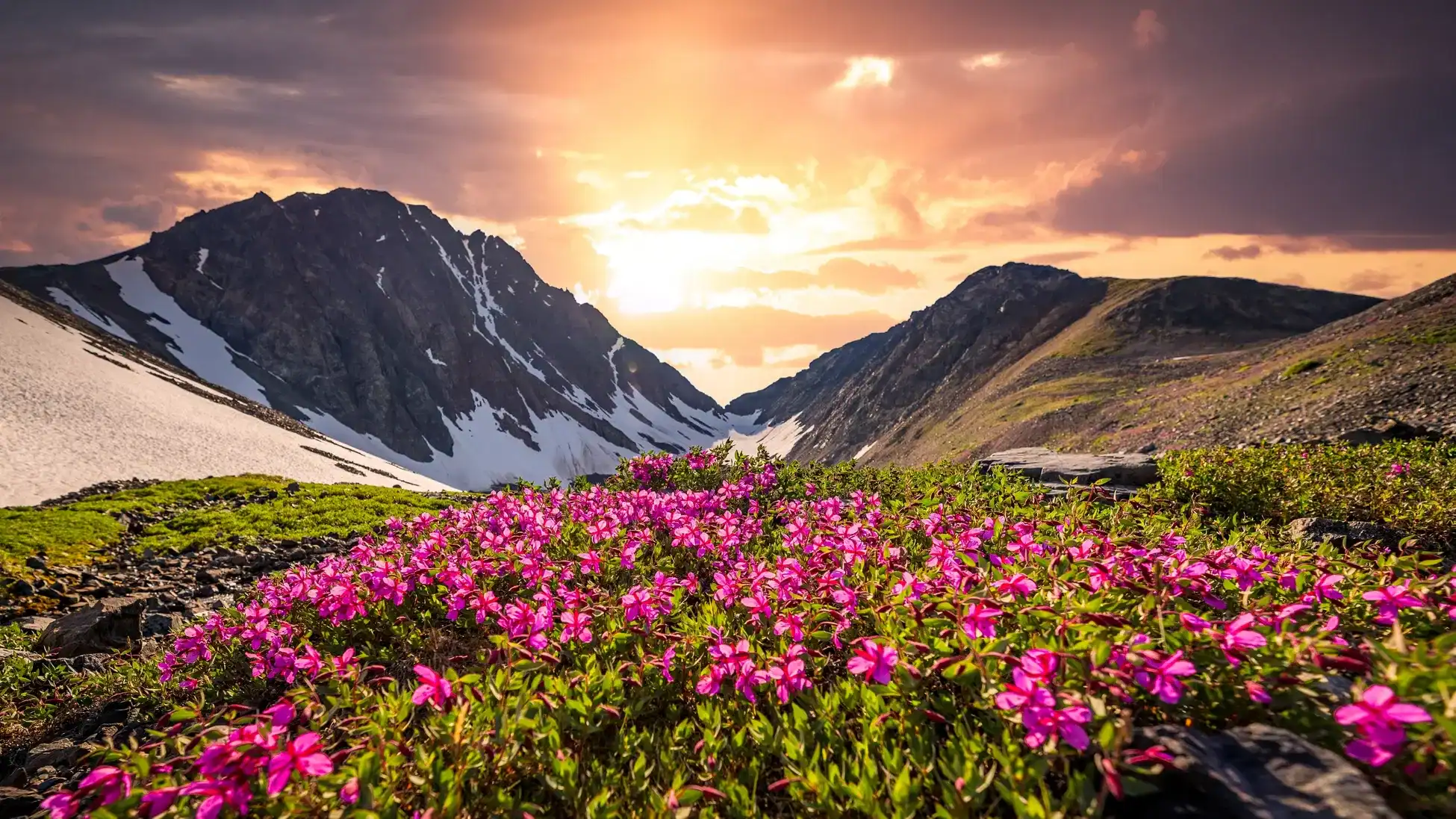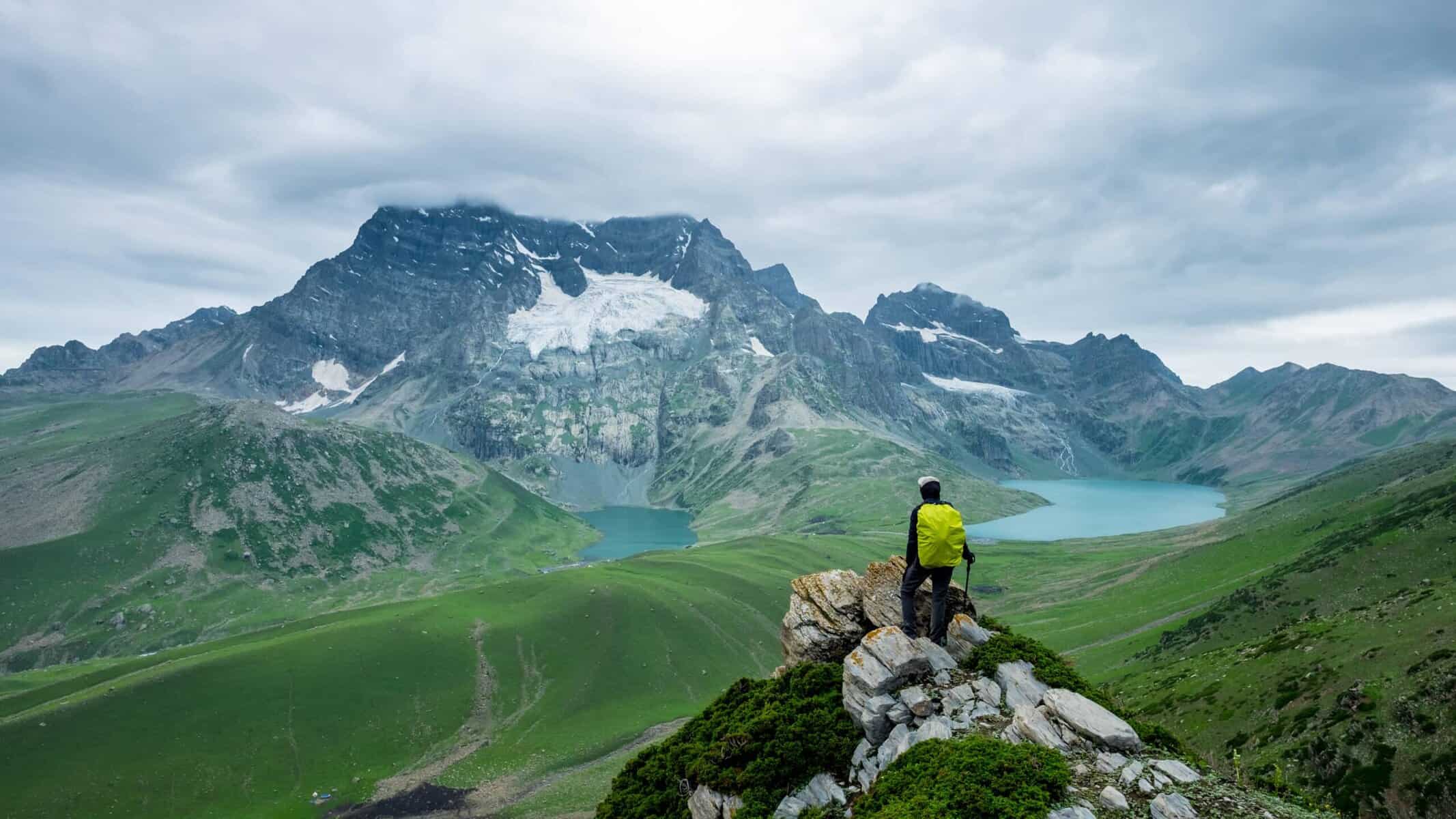Trek Grade
Easy
Highest Altitude
9,700 ft
Base Camp
Kareri Village
Best Time
Apr to June/Sept to Oct
Trek Distance
26 Km
Not sure which trek is right for you? Trekup India’s Mountain Experts have you covered.
Not sure which trek is right for you? Trekup India’s Mountain Experts have you covered. From figuring out if a trek matches your fitness level to knowing who you’ll be trekking with, we’re here to answer all your questions. Reach out to our Mountain Experts and plan your trek with confidence.
Kareri Lake Trek
The magical Kareri Lake sparks tranquility and a slice of heaven situated in Himachal Pradesh’s breathtaking terrains hidden in the Himalayas between the Dhauladhar range. An array of lush grasslands as well as thick forests of chilgoza pine and chir are accessible by embarking on this relatively arduous journey that is about 26 kilometers long. Apart from the fact that the picturesque waterfalls make the climax of this track, what distinguishes it is the picture-perfect turquoise waters of the glacial Kareri Lake itself. Witness the magic of the Himalayas by embarking on an unforgettable adventurous trip to Kareri Lake. What happens is; that as crystal-clear lakes collide with breathtaking mountains and vast cold deserts, it turns out to be a winter wonderland. Kareri, a quiet village, lies at Nature’s best-disposed spot, boasting various colored flowers. Besides they say that stone houses make up the best places for clicking Instagram photos due to their best nature’s color pallet. Beside this path are lofty oak and pine trees together with other types of trees commonly found in the area. Found in the vicinity of Dharamshala, the trek provides a serene escape from bustling city life, giving you a chance to embrace the calmness that exists in nature.
Fix Departure Dates!
Trek Cost Inclusions and Exclusions!
Trek Cost Inclusions
- Stay: 1 Night tented accommodation at respective campsites of Trekup India on a sharing basis.
- Meals: Trekup India provided cooked meals during the trek starting with Lunch and Dinner on Day 01 to Breakfast on day 2 (Meals are simple, nutritious, and vegetarian and non-repeated meals)
- Transport: On sharing vehicle
- Trek Equipment: Sleeping bag, Sleeping tents, Kitchen tent, Dining tent, Toilet Tents.
- Amenities: All utensils, sleeping mattresses (Black foam mats), Crampons, and Gaiters for snow.
- Health & Safety: First Aid Box, Oxygen Cylinders, Stretchers, Oxi meters, BP Machines, health.
- Permits: Forest Permits and Camping Permission Fee
- Trek Crew: High Altitude Chef, Helpers, Trek Leader & Guides, and other support team.
- Potters & Mules: Potters and Mules to carry all trekking equipment, ration, and vegetables.
Trek Cost Exclusions
- GST 5% (it is Mandatory)
- Any kind of insurance (Trekup India recommends each trekker to get insurance)
- Any Meals/accommodation beside the itinerary or not mentioned in the program.
- Any Bus / Airfare to/from trek start/end point
- Personal Medical expenses – do carry your medication.
- Any personal services such as Laundry, phone calls, liquors, mineral water, etc.
- Any still / video camera fee
- Any Entrance fee Monuments, Monasteries, Museums, Temples – Pay directly on the spot.
- Mules or porter charges to carry private baggage (Offload Charges for bag 500 per day, per bag. Note: Bag weight should not be more than 10 kg.
- Any kind of emergency evacuation charges
- Any services that are not mentioned in the cost inclusion section.
Why Choose Trekup India?
Videos by experts watch these videos to prepare well for a Successful Trek

Want To Trek Like Pro?
Basically, watch these videos if you want to trek the same way professional trekkers do and make your skills better. These videos contain useful tips and techniques to further improve your trekking skills itself. These videos actually help both new and experienced trekkers improve their trekking skills. These videos definitely provide useful tips that make your trek better. We are seeing that these videos by Trekup India experts will only help you make your trekking skills better.
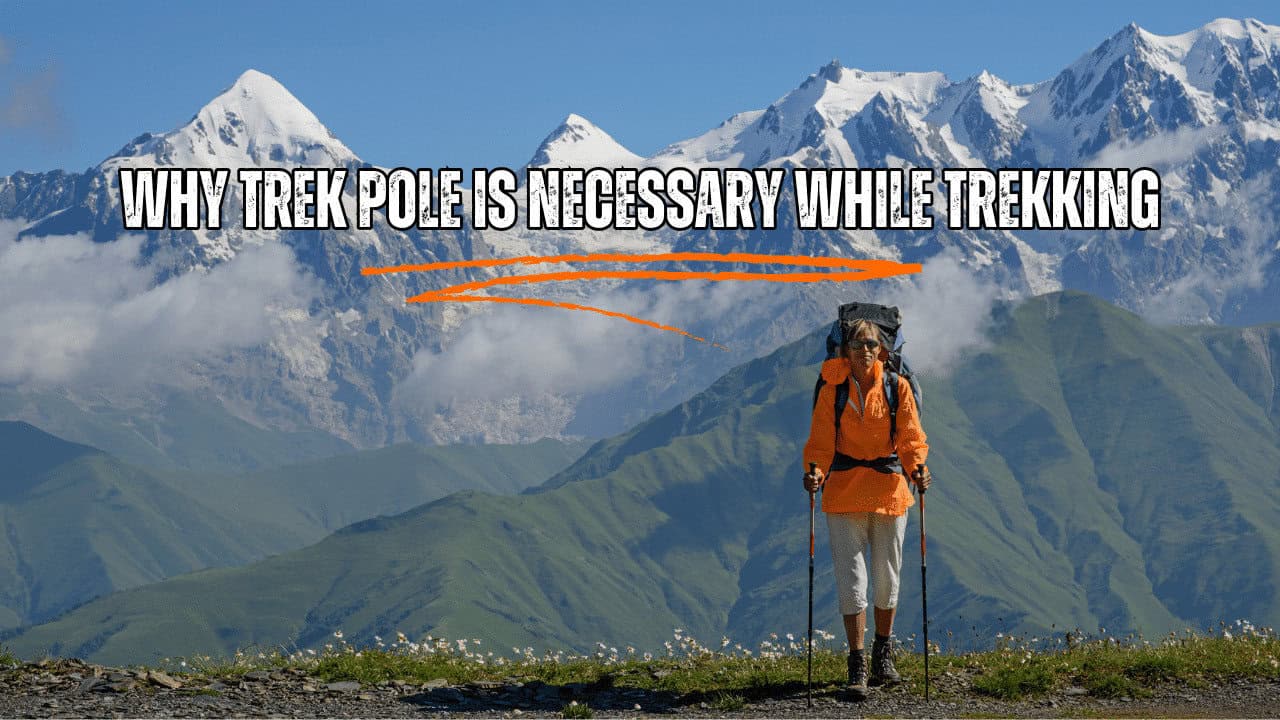
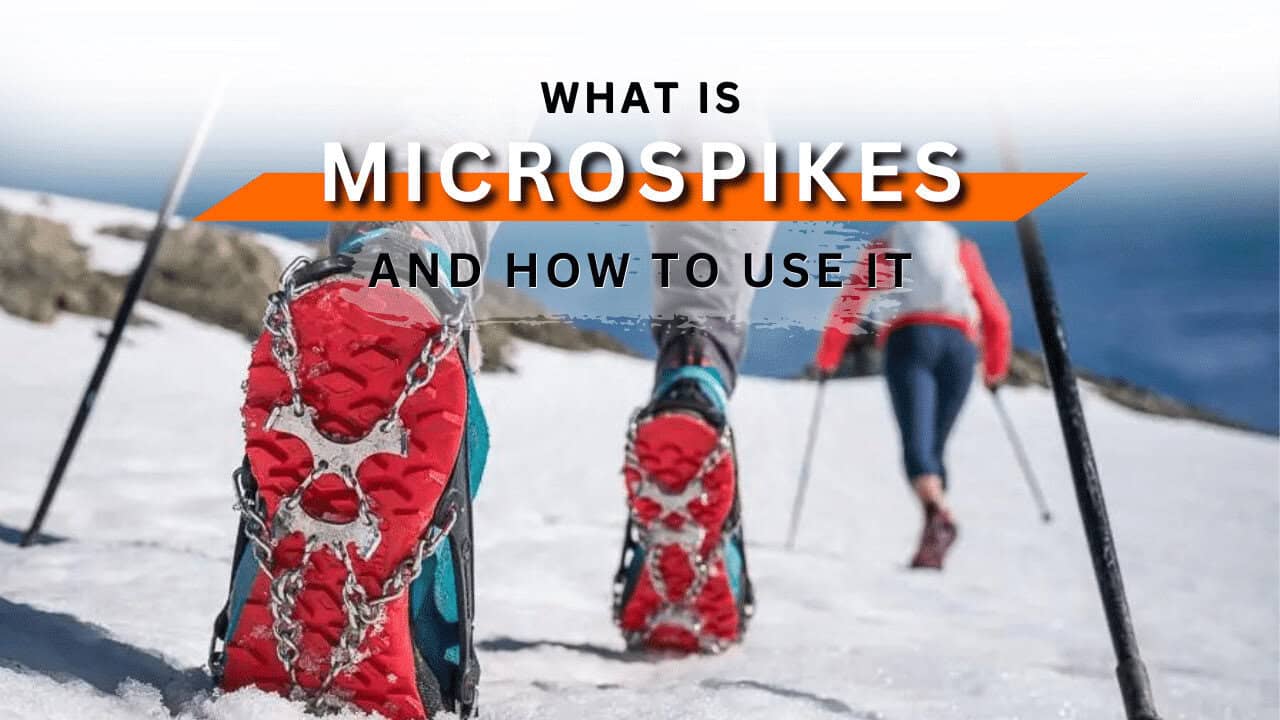
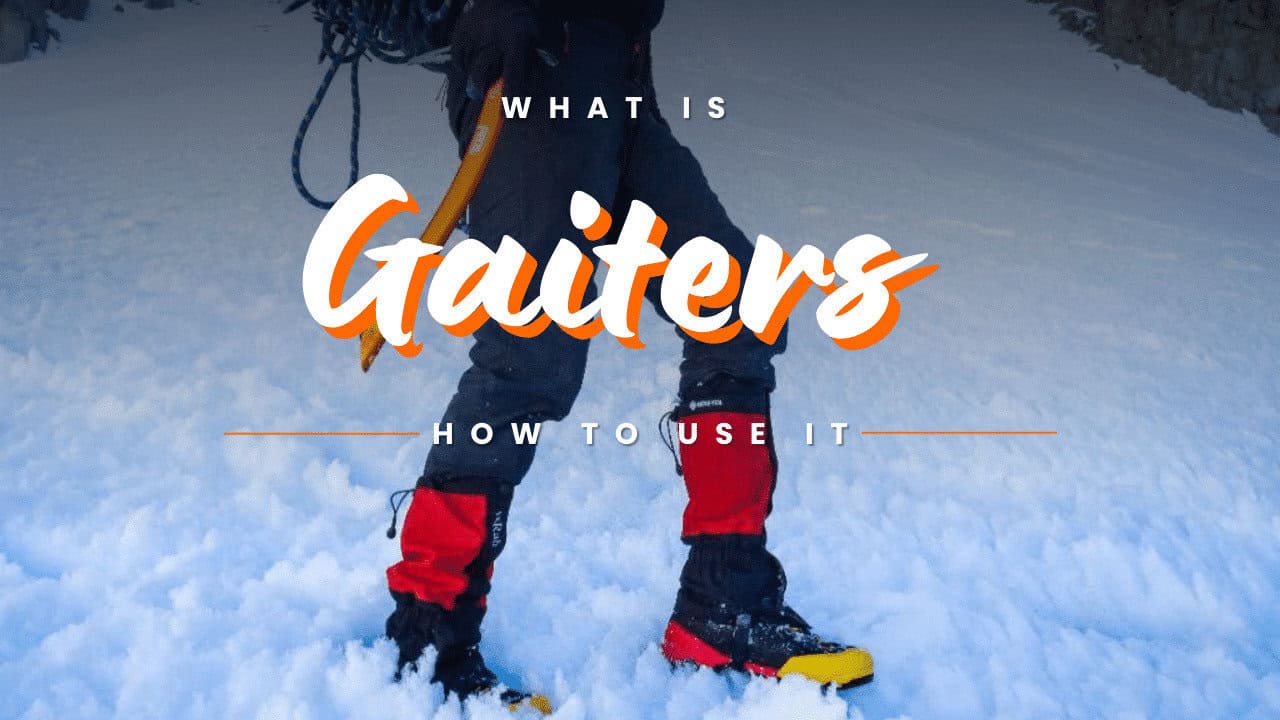
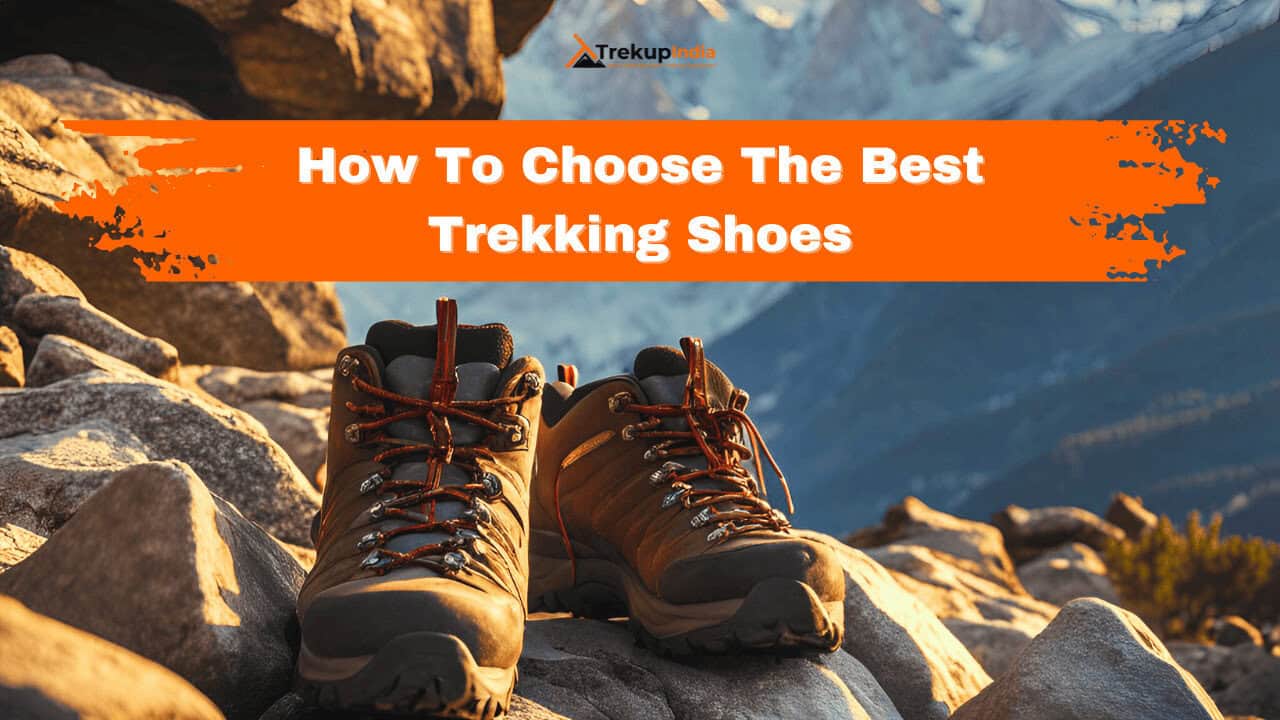

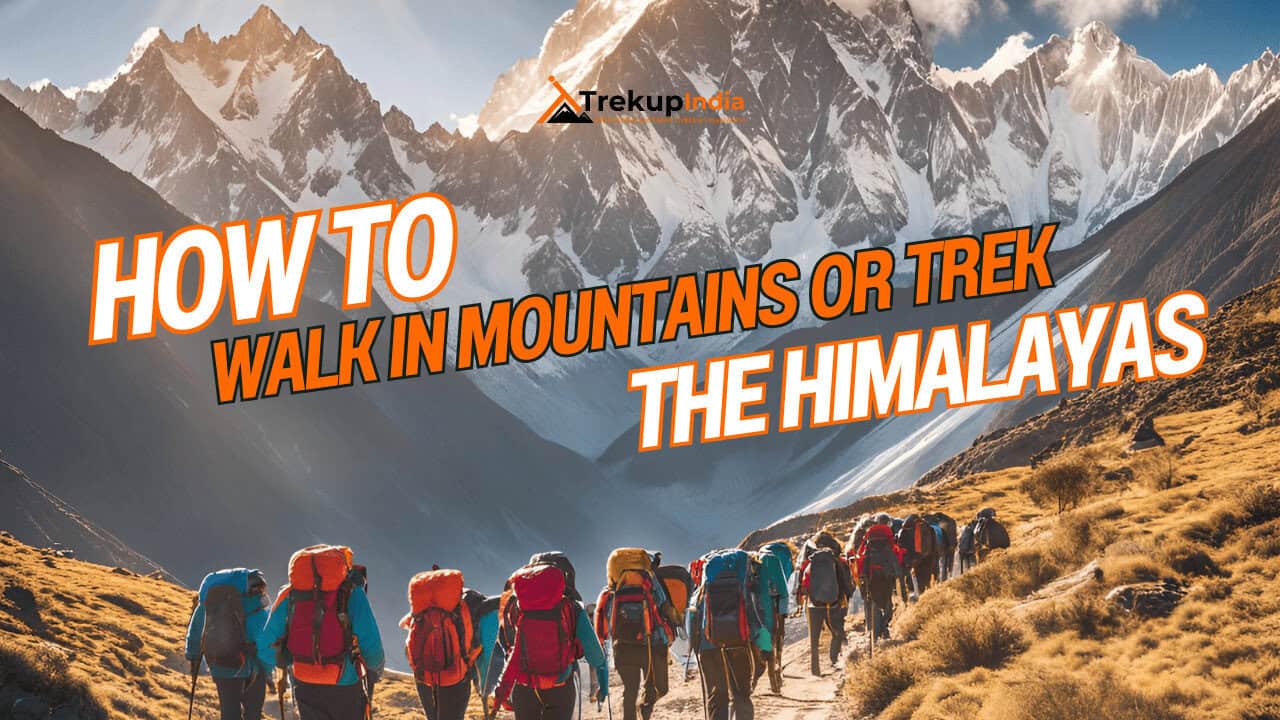
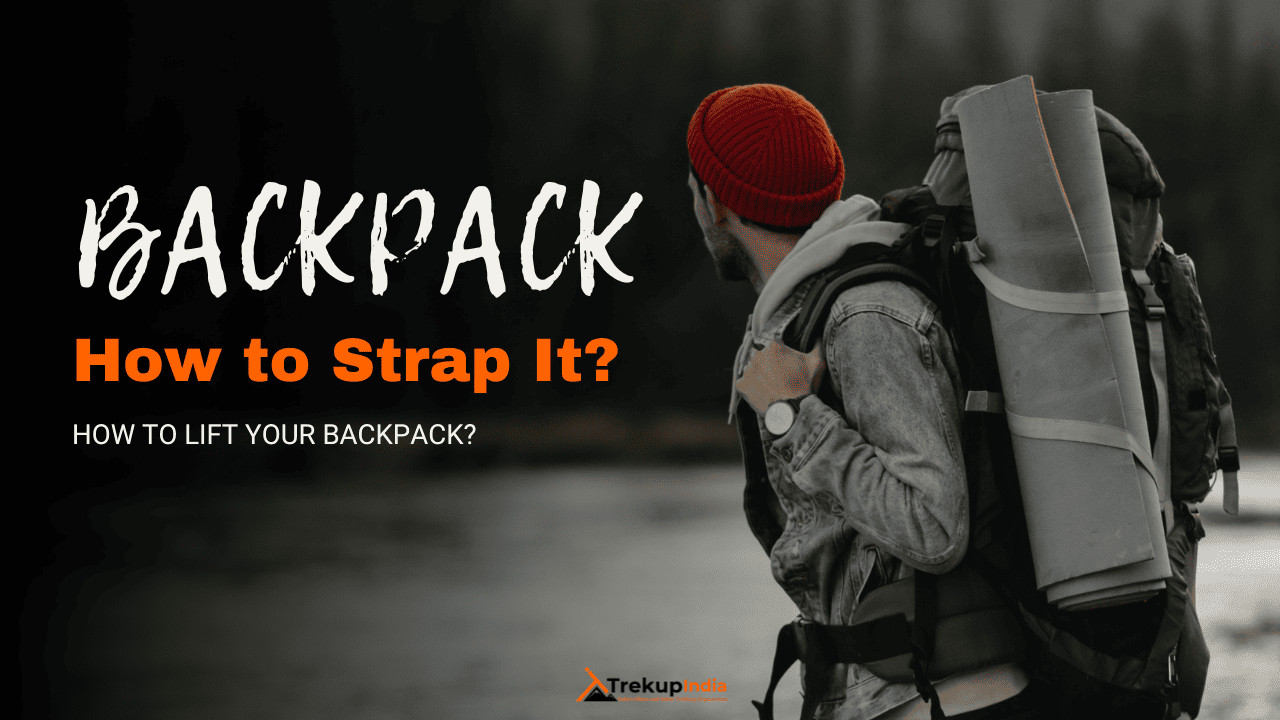
Know Everything About Acute Mountain Sickness
Acute Mountain Sickness occurs when people trek to high altitudes above 8,000 feet. This condition itself develops further due to reduced oxygen levels at such heights. Basically, as you go higher up, the air pressure and oxygen levels decrease, which causes the same problem. Acute Mountain Sickness surely causes headache, nausea, vomiting, and dizziness in affected persons. Moreover, peoples also experience difficulty in sleeping during this condition. To avoid mountain sickness, you should actually trek up slowly to higher altitudes. To learn further about this condition itself, watch the videos by Trekup India.
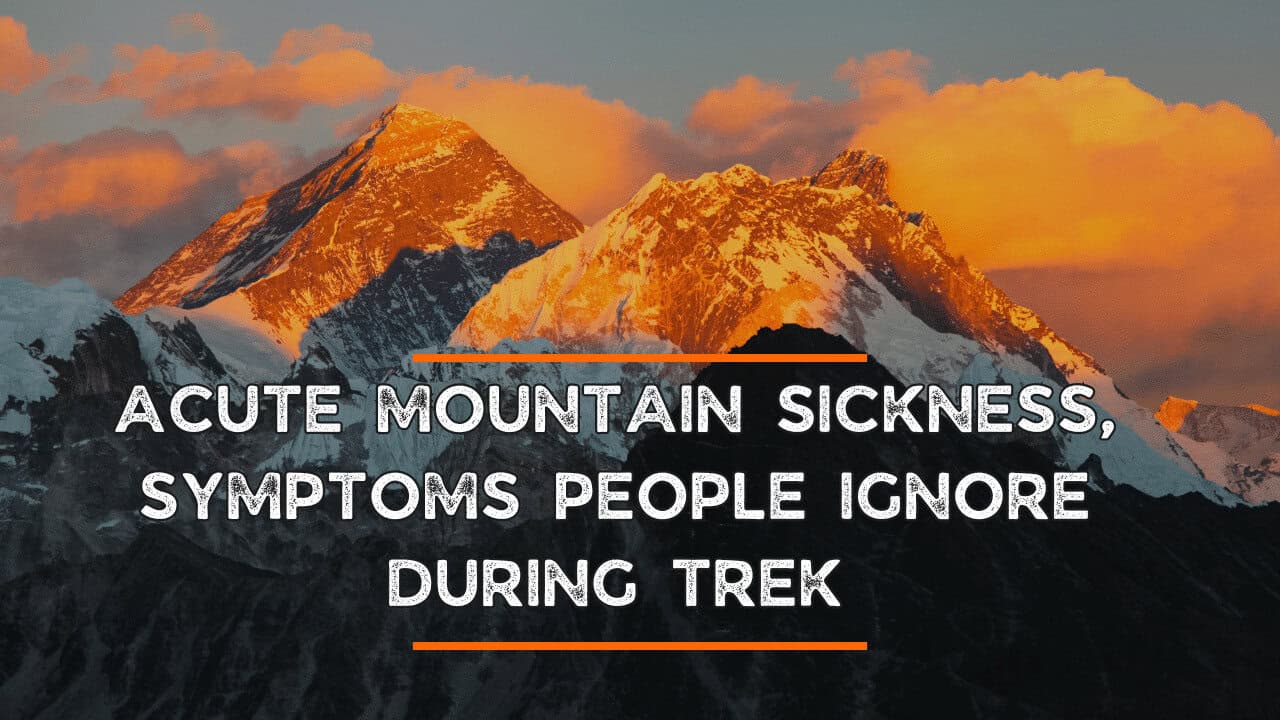
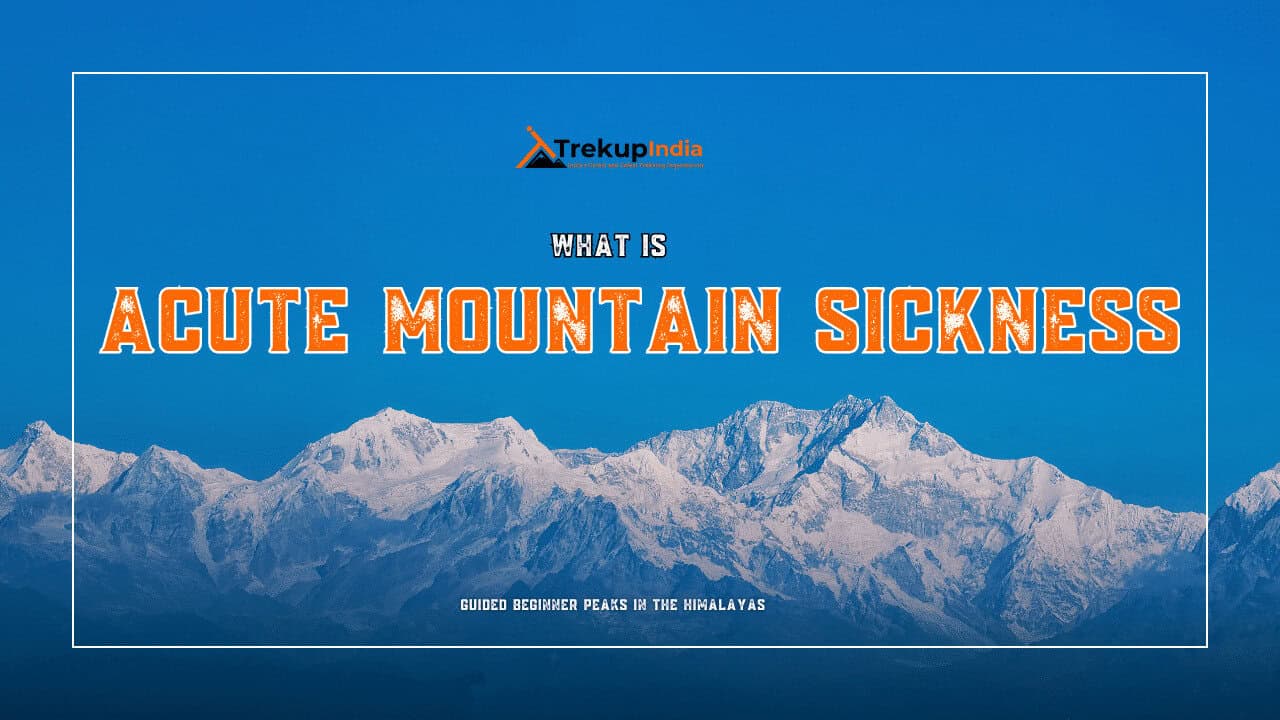
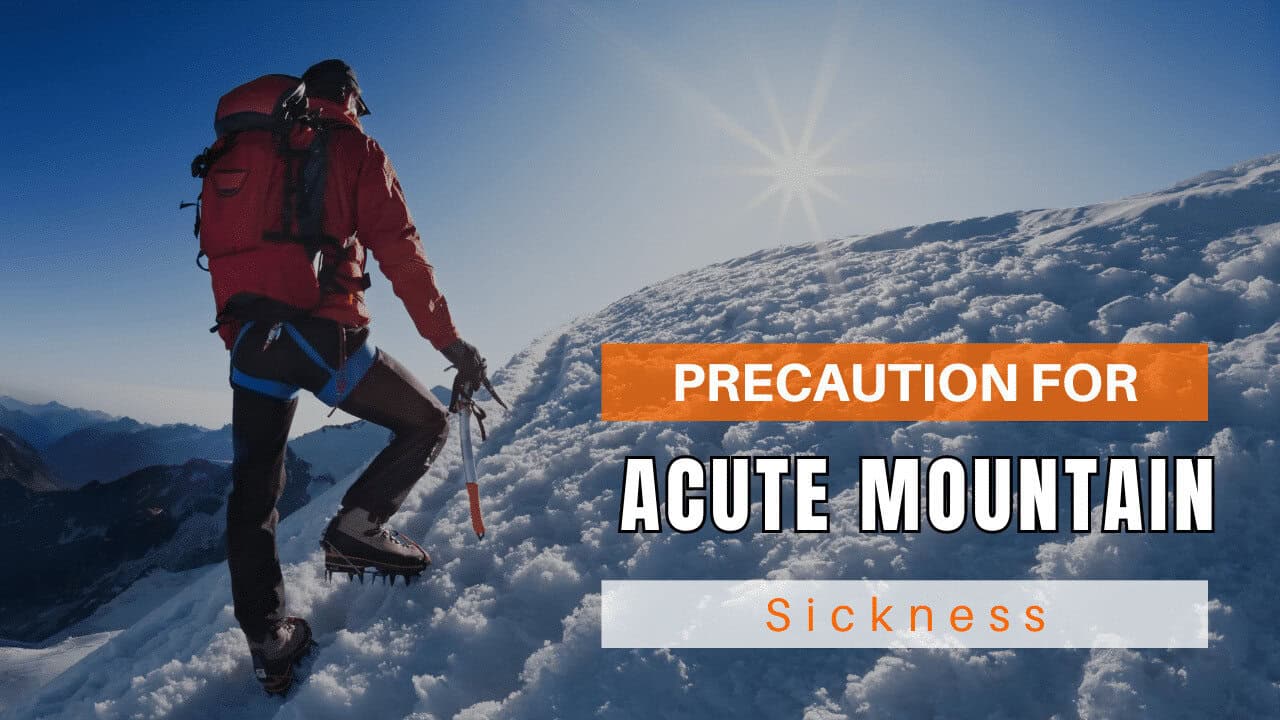
Day Wise Detailed Itinerary of Kareri Lake Trek
Day 1: Dharamshala to Kareri Village Drive and Trek to Liyoti
- Altitude: Dharamshala (1,475m) → Kareri Village (1,200m) → Liyoti (2,250m)
- Drive Distance: 27 km | 2–3 hrs
- Trek Distance: 8 km | 4–5 hrs
- Difficulty: Easy to Moderate
- Water Sources: Mountain streams, small nallas en route
The Kareri Lake Trek adventure begins with an early morning departure from Dharamshala. The journey towards Kareri Village takes approximately 2-3 hours, covering 27 km of mountain roads that provide breathtaking panoramic views of the Dhauladhar range. It is possible to pass through McLeod Ganj before navigating small roads that slowly take you out of the crowded tourist areas to the peaceful countryside.
Once you’ve reached Kareri Village (1,200 meters), you’ll have to register at the forest checkpoint and pay the necessary entry fees. This charming village is the official start point to begin your trek. Spend some time exploring the local culture. The friendly villagers are always willing to tell stories about the region and provide insight into their traditional way of living.
The trek between Kareri Village to Liyoti covers approximately 8 km and takes about 4-5 hours. The first trail is clearly marked and easy while you walk through fields with terraces and hamlets that are small hamlets. You’ll pass over several wooden bridges crossing mountain streams, each one of them offering stunning photos.
As you ascend in altitude, the landscape changes dramatically. Rhododendron and oak forests cover the path, creating a lush green canopy over your head. In spring (March-May), the Rhododendrons explode into vibrant pink and red blooms, which make the trek even more breathtaking.
The trail gets steeper as you reach Liyoti, the camping location to stay the night, at 2,250m. The air is getting less humid and colder, so make sure to layer up in the right way. Liyoti is basically a gorgeous meadow, surrounded by majestic mountains, giving you your first experience of the alpine landscape which awaits higher up.
Get your tent set up and ready for a cold night. The temperature will drop dramatically following sunset, so make sure that your sleeping bag is suitable for freezing temperatures. The mountain air is clear and offers incredible opportunities to observe stars. Don’t miss your chance to view the Milky Way in all its splendor.
Day 2: Trek To Kareri Lake and Back To Liyoti
- Altitude: Liyoti (2,250m) → Kareri Lake (2,950m)
- Trek Distance: 12 km (6 km each way) | 6–7 hrs total
- Difficulty: Moderate to Challenging (rocky ascent, stream crossings)
- Water Sources: Streams near meadows & lake
The second day is the most memorable of the Kareri Lake Trek. You’ll rise early to watch sunrise over the surrounding peaks before starting the ascent towards the lake. The trek from Liyoti to Kareri Lake covers 6 kilometers and usually takes 3-4 hours. The difficult terrain requires a steady pace as well as frequent breaks.
The trail begins by passing through alpine meadows filled with wildflowers during warmer months. Several stream crossings may necessitate careful navigation, particularly during the monsoon season and early spring when the water levels are high. Waterproof boots are crucial for this particular section.
As you ascend the hill, the vegetation gets sparser and the landscape acquires an edgier, lunar-like appearance. The path winds up the steep rocky sections, and you’ll have to reach for your hands often to stay in balance on slippery scree slopes. Be patient to get there – the altitude of 2,950 meters can cause problems for experienced trekkers.
Kareri Lake finally reveals itself after a gruelling final ascent. The glacial lake, tucked away in an amphitheater formed by the towering mountains, is truly stunning. The crystal clear water reflects the surrounding mountains and creates a mirror-like look that is perfect for photography. The lake is partially frozen during the summer months, which adds to its stunning beauty.
Spend your time at the lake, exploring the area, and soaking up the incredible 360-degree mountain views. The Dhauladhar range dominates the horizon, with numerous unnamed peaks providing a stunning backdrop. There are a few wildlife in the area, including Himalayan birds, and occasionally mountain goats grazing on ridges.
After lunch and a number of photo opportunities, you’ll return the steps to return to Liyoti, where you’ll spend your second night. The descent is a task that requires careful consideration, particularly on sections of loose rock where it can be difficult to find a foot. Trekking poles are a must to ensure stability on the descent.
Day 3: Descend to Kareri Village | Drive Back to Dharamshala
- Altitude: Liyoti (2,250m) → Kareri Village (1,200m) → Dharamshala (1,475m)
- Trek Distance: 8 km | 3–4 hrs (descent)
- Drive Distance: 27 km | 2–3 hrs
- Difficulty: Easy (downhill, but knees require care)
- Water Sources: Streams till Kareri Village
The day’s final adventure begins with a break at Liyoti and getting ready for the trek back to Kareri Village. This 8-kilometer downhill trek generally takes between 3 and 4 hours, but it is important to take your time and be cautious to avoid knee strains and slips on the steep slopes.
The morning light that filters through the forest provides stunning photographs as you climb through the rhododendron and oak trees. You’ll return to your route from the beginning; however, the perspective from the bottom provides completely new perspectives of the landscape that you walked through two days prior.
Make sure to make multiple stops to take in the things you may have missed on your upward journey. The terraced fields become prominent as you drop elevation, and you’ll listen to the sounds of village life becoming more prominent as you get closer to Kareri Village.
Once you’ve reached the village, when you get to the town, you’ll be done with the Kareri Lake Trek successfully. This is a great opportunity to meet with locals or buy a few traditional food items, or relax before returning to Dharamshala.
The return journey to Dharamshala allows you to think about your mountain adventure while observing the scenery change from rural villages towards the bustling hills. The time to arrive is Dharamshala by the end of the afternoon, having completed an unforgettable trip that is a mix of physical challenge and incredible nature beauty.
You can celebrate your accomplishment with a hearty meal at McLeod Ganj, where you can share your experiences from your trek with other travelers and begin thinking about the next Himalayan adventure.
We’ve prepared a comprehensive Trek Route Map for your upcoming adventure to Kareri Lake Trek, which outlines the entire journey including all stops and trails. This map provides detailed information on the terrain, distance between points of interest, and estimated travel time to help ensure a safe and enjoyable trek. We’ve carefully curated the map to ensure that you have all the necessary information at your fingertips. Please take a moment to review it thoroughly, and don’t hesitate to reach out if you have any questions or concerns.
The Trek Altitude Chart is a useful tool for Trekkers to monitor their altitude changes during their rides, allowing them to plan their routes more efficiently and track their progress over time. This Kareri Lake Trek chart is beneficial for both casual and experienced Trekkers, helping them make the most out of their Trek experience.
What should you pack for the Kareri Lake Trek
Kareri Lake Trek is a high-altitude trek. The trekking gear you have to have for this particular trek differs from normal treks. Thus, read this whole segment. There is an important question that the trekker who is doing trek asks, like what all things to carry while trekking. Below, we have provided the details on everything you should take; an easy way to remember is by Head to foot or foot to head. We have prepared from Head to foot.
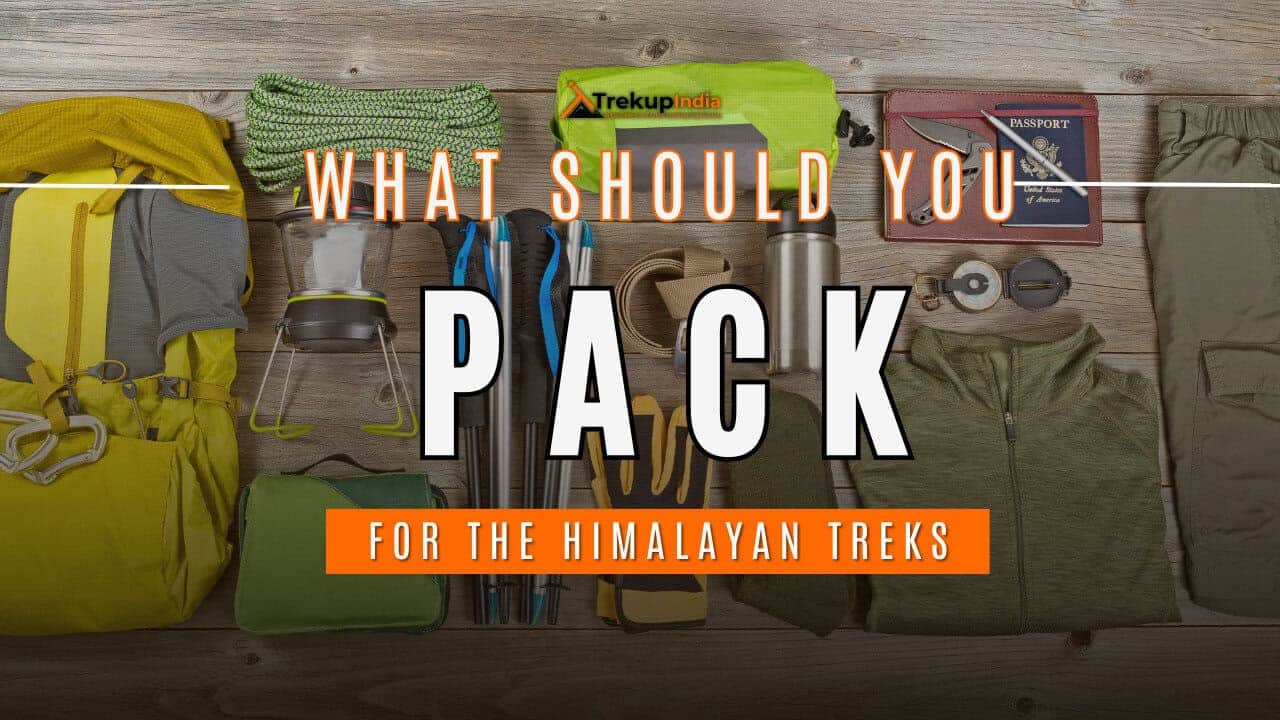
Head Gears
When trekking it's important to carry headgear to protect your head and face.
Heading out for a trek? Don’t forget to carry headgear to protect your beautiful face and head from the sun, wind, and dust! It’s an essential accessory that keeps you safe and comfortable throughout your adventurous journey. So, make sure you pack it before you step out into nature!
- Head Lamps – When trekking at night, headlamps are essential to illuminate your path while keeping your hands free. Headlamps come in different sizes and lumens, so it is essential to choose one that suits your needs.
- Hats or Cap – Caps or hats are also necessary when trekking in different weather conditions. Caps protect your head from the wind and freezing temperatures at night, while hats provide shade and protection from the sun during the day. It’s essential to ensure that your hat has a strap to prevent it from being blown away by the wind.
- Sunglasses – Sunglasses are also essential for trekking. Your sunglasses should protect your eyes from harmful UV rays and fit your face perfectly to avoid falling off while climbing, jumping, or crossing obstacles. The glass of your sunglasses should also be designed for different weather conditions to provide optimal visibility.
- Buff / Balaclava – Lastly, a buff or balaclava is a must-have to protect your mouth or neck from extreme temperatures and keep them warm. Buffs and balaclavas come in different materials, thicknesses, and designs, so it’s important to choose one that suits your needs and preferences. Depending on the weather conditions and your activities, you can wear them as neck warmers, face masks, or headbands.
Clothes
When trekking in high altitudes, prepare for cold weather by wearing layers. Layering traps heat, keeps you warm, and allows you to easily adjust your clothing as temperatures fluctuate.
Layering is important for different seasons when trekking. When planning a high-altitude trek, it is important to prepare for the cold weather. Wearing layers is the best approach as it provides both protection and flexibility when the weather changes frequently in the mountains. Layering helps to trap heat and keep your body warm, while at the same time allowing you to easily adjust your clothing as the temperature fluctuates. By wearing layers, you can enjoy your trek comfortably and stay safe in the unpredictable mountain weather
- For spring, summer, and monsoon treks, consider wearing three layers: a woollen sweater, a fleece, and a padded jacket.
- For autumn treks, add one more fleece layer to make it four layers.
- For winter treks, you may need five layers with thermals, a woollen sweater, two fleeces, and a padded jacket.
- T-shirt/sleeve shirt– Bring three T-shirts and two quick-dry trek pants, wearing one and carrying the others. Long sleeve shirts help to protect from sun UV rays. We recommend synthetic T-shirts as they get dry quickly when they get wet.
- Hiking / Trekking Jacket– down jackets (-5 to-10 C) or two-three-layer jackets.
- Thermals– at least two pairs of thermals help keep the body warm during cold weather.
- Undergarments– you can carry them according to your habitual and hygiene requirements.
- Gloves– 1 pair of gloves will keep your hand warm and nice.
- Trek Pants– Bring 2 to 3 comfortable trekking pants. Trekking pants play a significant role, as they are designed for comfort and mobility, making trekking easier. It should be Synthetic so that it gets dry quickly when wet.
- Rain Wear– you can carry a raincoat or Poncho. During long rains and snowfalls, the waterproof jackets start leaking. Still, the Poncho and raincoats keep you dry, so choose accordingly.
Tip: If you choose a raincoat on your trek, carry a small waterproof cover so things inside your backpack can’t get wet. If you carry a Poncho, you don’t need to worry. It protects both you and your backpack.
Foot Gears
When it comes to planning a trek, one of the most important aspects is to ensure that you have the right kind of foot gear.
- Trekking shoes which are waterproof and have ankle support. Walking / Hiking sandals which can be used off the trek, i.e., in the morning and evening hours when you reach the campsite, basically to get your feet rest from heavy boots, sometimes used for crossing streams and rivers, it’s more comfortable and safer than crossing barefoot or wetting your shoes. Sneakers (Optional) can be worn for normal driving days or used around the camp.
- Socks– you should at least carry 3 to 4 pairs.
- Microspikes & Gaitorswill be provided by Trekup India when required. You don’t have to carry them.
Personal First Aid Kit
Don't forget to pack your personal first aid kit! It's always better to be safe. So, make sure you're prepared for any unforeseen circumstances.
Below are some common medicines generally required/used during your adventure trip; however, please consult your doctors prior.
- Antiseptic towel or water syringe (to clean the wound)
- Butterfly bandage for a small cut
- Cotton and elastic bandages and sterile gauze pad for larger wounds
- Latex gloves are used when the wound bleeds.
- Medicine for Diarrhea (Upset stomach)
- Medicine for cold, flue/fever, headache
- Some pain killers
- ORS pouches
- Quick pain relief spray (External use)
- Any personal medicine prescribed by your doctor
- Dimox / Similar for high altitude sickness
- Bug Repellent
- Carry some nutria/energy bars and drinks (non-alcoholic)
- Note: Kindly consult your doctor before purchasing or taking any medicine.
Gadgets and Other Items
You might also consider bringing a camera, binoculars, portable charger, and snacks. Be well-prepared and tackle any trail with confidence.
- Trekking Poles
- Mobile phone
- Camera
- Spare batteries for phone and camera, power bank
- Lightweight flashlight or headlight
- A waterproof bag made of plastic is used for the camera.
- Plug/converter for electrical items
- 1-litre water bottle
- A journal with a pen would be a good idea to keep your notes.
- Some book of your interest for the ideal time
- Get into the habit of maintaining a Map and guidebook of the region.
Hygiene & Personal toiletry
Remember to pack hygiene and personal toiletry items such as soap, shampoo, toothbrush, toothpaste, deodorant, and toilet paper.
- Sunscreen with UV protection to shield your skin from harmful rays
- 1 or 2 small quick-drying towels to help you dry off quickly in case of rain or sweat
- Toilet paper, tissues or wet wipes for maintaining hygiene while on the trek
- Toothbrush, toothpaste, and mouth freshener to keep your mouth clean and fresh throughout the journey
- Deodorant or talcum powder to help you stay fresh and odor-free, especially during hot and humid climates
- Shampoo to keep your hair clean and healthy
- Sanitary pads or tampons (for female trekkers) to manage menstrual cycles
- Lip-gloss or salve to protect your lips from dryness and chapping
- Bio-degradable soap to keep yourself clean and hygienic while on the trek
- Nail clipper and other personal items that you use daily
Compulsory Documents to Carry
There are certain documents that you should always carry with you. These documents are not only necessary for your safety and security, but they may also be required by local authorities.
These files must be submitted to the Forest Department before your trek. With none of these, you will not be permitted to trek—original and photocopy of government photo identity card. Carry IDs like Aadhaar, voter ID, etc.
How To Plan Your Trek & Reach Kareri, Himachal Pradesh?
- By Air: The town is so close to Gaggal Airport and which is located at a distance of 18 kilometers. Gaggal is connected to major cities such as Delhi and Chandigarh by regular flights. From the airport, a taxi can be hired to take one to Ghera or Kareri village.
- By Train: The closest major railway station to Kareri Village is located around 85 km from Pathankot. The city of Pathankot is well connected to various Indian cities. From Pathankot, you can catch a taxi or bus to reach Kareri Village.
- By Road: Kareri Village is well-connected by road to major cities in North India. Regular bus services, including Volvo and state-run buses, operate from Delhi, Chandigarh, and other nearby cities. You can also drive to Kareri Village, enjoying the scenic journey through the hills.
Fitness Required & Preparation Guide For Kareri Lake Trek
If you’re preparing for a Kareri Lake Trek, Trekup India recommends jogging as part of your fitness routine. Jogging helps work out the same muscle groups that you’ll use during trekking and can help you build endurance. You don’t need any special equipment to get started.
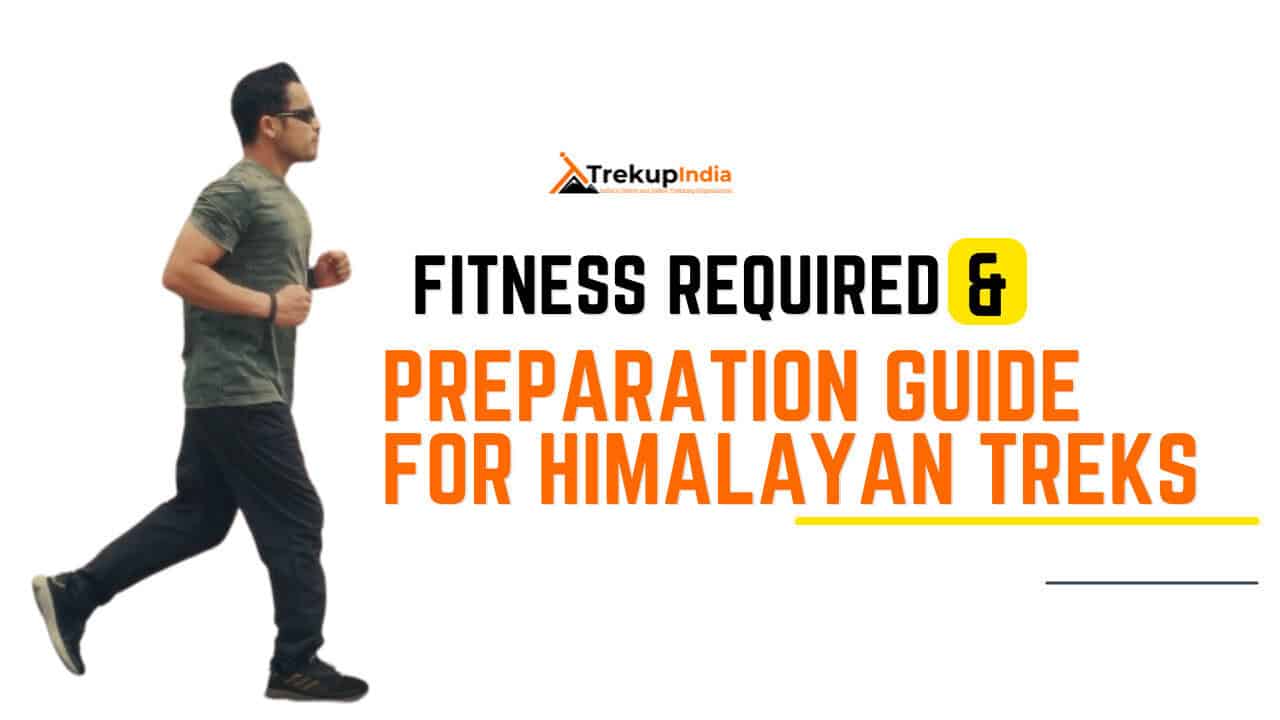
Fitness Target
Trekup India has put the Kareri Lake Trek into an easy-to-moderate-grade-level trek.
For Easy – Moderate Treks – In order to be well-prepared for your upcoming trek, it is recommended that you focus on building your endurance by aiming to cover a distance of 4.5 kilometers in less than 45 minutes. This will help you to develop the necessary stamina and strength required to successfully complete your journey.
How to Achieve This Fitness Target?
To start preparing for your trek:
- Try jogging for at least five days every week.
- If you find 4.5 km too difficult at first, begin with 2 km and gradually increase over 2-3 weeks.
- Once you feel more comfortable running 4.5 km, focus on improving your speed gradually on a daily basis.
It is important to ensure that you can consistently complete 4.5 km in under 45 minutes for at least two weeks before your planned trek. Allow yourself 6-8 weeks to prepare physically for the journey.
Strength Training exercises that benefit Trekking
Trekking is an activity that demands a good level of strength.

Trekking is a demanding activity that requires good cardiovascular endurance, muscular strength, and overall fitness. To help you prepare for your trek, incorporating bodyweight exercises into your training routine can be an effective way to build strength, improve stability, and enhance endurance, all of which are crucial for a successful trek. In this regard, here’s a breakdown of body weight exercises categorized by the specific body parts they target and the benefits they offer during trekking.
1. Lower Body Exercises
Lower body exercises like squats and lunges are great for building lower body strength, essential for trekking.
a. Squats
Squats are an excellent exercise for building lower body strength, essential for trekking. They target the quadriceps, hamstrings, glutes, and calves. Solid quadriceps and glutes provide power for ascending and tackling uphill climbs, while vital hamstrings aid stability during descents. This is particularly helpful in navigating uneven terrain during trekking.
How to perform Squats Exercises:
- Stand with feet shoulder-width apart, toes pointing slightly outward.
- Lower your body by bending your knees and hips, keeping your back straight.
- Lower until your thighs are parallel to the ground or as low as comfortable.
- Push through your heels to return to the starting position.
b. Lunges
Lunges target the quadriceps, hamstrings, glutes, and calves. They improve lower body strength, balance, and stability, crucial for maintaining control on rocky trails and steep slopes. Additionally, they enhance flexibility, reducing the risk of injury while trekking.
How to Perform Lunge Exercises:
- Stand with feet hip-width apart, hands on hips or sides.
- Take a step forward with one foot, lowering your body until both knees are bent at 90-degree angles.
- Push through the heel of your front foot to return to the starting position.
- Repeat on the other side, alternating legs.
2. Upper Body Exercises
Upper body exercises such as push-ups and pull-ups effectively strengthen the upper body, especially the chest and shoulders, which are essential for carrying a backpack during treks.
a. Push-Ups
Targets: Chest, shoulders, triceps, and core.
Benefits for Trekking: Push-ups are an effective exercise to strengthen the upper body, especially the chest and shoulders, essential for carrying a backpack during treks. Improved upper body strength will also help maintain posture and stability while traversing challenging terrain.
How to Perform Push-Ups Exercises:
- Start in a plank position with hands shoulder-width apart and body in a straight line from head to heels.
- Lower your body by bending your elbows until your chest nearly touches the ground.
- Push through your palms to return to the starting position.
- Keep your core engaged throughout the movement.
b. Pull-Ups/Bodyweight Rows:
Targeting the back, biceps, and shoulders can significantly benefit trekking. You can strengthen these muscle groups by performing pull-ups or bodyweight rows and improve your posture and balance while carrying a backpack. Additionally, more muscular back muscles can help reduce the risk of back strain and fatigue during long treks, making your journey safer and more comfortable.
3. Core Exercises
Core exercises like planks and Russian twists can help strengthen the core muscles, which are crucial for maintaining stability and balance while trekking on uneven terrain.
a. Planks
Targets: Abdominals, obliques, and lower back.
Benefits for Trekking: Planks are an effective exercise that helps strengthen the core muscles. These muscles are crucial for maintaining stability and balance while trekking on uneven terrain. A strong core also helps improve posture, reducing the risk of back pain and fatigue during extended hikes.
How to Perform Planks Exercises:
- Start in a plank position with elbows directly under shoulders and body in a straight line from head to heels.
- Engage your core and hold the position, avoiding sagging or arching the back.
- Keep breathing steadily and hold for the desired duration.
b. Russian Twists
Targets: Obliques, abdominals, and lower back.
Benefits for Trekking: Russian twists engage the core muscles, particularly the obliques, improving rotational stability and balance. Enhanced core strength helps prevent injuries and improves overall performance during trekking.
How to Perform Russian Twist Exercises:
- Sit on the ground with knees bent and feet flat, leaning back slightly to engage the core.
- Clasp hands together and twist the torso to one side, bringing the hands towards the ground beside the hip.
- Return to the centre, then twist to the other side.
- Continue alternating sides for the desired number of repetitions.
4. Full Body/Cardiovascular Exercises
Full-body/cardiovascular exercises like burpees and mountain climbers are excellent for improving cardiovascular endurance, strength, and agility.
a.Burpees
Burpees are an excellent full-body exercise that targets your legs, chest, arms, and core. This exercise dramatically benefits trekking enthusiasts, improving cardiovascular endurance, strength, and agility. Regularly incorporating burpees into your workout routine can enhance your overall fitness level, which can help you endure long hikes and rugged terrains with ease.
How to Perform Burpees Exercises:
- Start in a standing position.
- Squat down and place hands on the ground.
- Jump feet back into a plank position.
- Perform a push-up.
- Jump feet back to the squat position.
- Explosively jump up into the air, reaching overhead.
- Land softly and repeat the sequence.
b. Mountain Climbers
Mountain climbers target the core, shoulders, chest, and legs. This dynamic, full-body exercise can significantly improve cardiovascular endurance and agility. It is an excellent functional workout for trekking preparation as it engages both the upper and lower body muscles while strengthening the core muscles.
How to Perform Mountain Climbers Exercises:
- Start in a plank position with hands shoulder-width apart and body in a straight line from head to heels.
- Drive one knee towards the chest, then quickly switch legs, alternating in a running motion.
- Keep the core engaged and the hips stable throughout the movement.
- Continue at a moderate to fast pace for the desired duration.
Incorporating bodyweight exercises into your training routine can help you build strength and endurance and prepare your body for the physical demands of trekking. Consistency and proper form are crucial to maximizing the benefits of these exercises and ensuring a safe and enjoyable trekking experience. Engaging your core muscles, including obliques, abdominals, and lower back, with Russian twists can improve your rotational stability and balance, preventing injuries and enhancing overall performance during trekking.
When incorporating strength training exercises into your workout routine, it’s essential to maintain proper form and technique to avoid injury. Start with lighter weights and gradually increase the intensity as you progress, focusing on compound exercises targeting multiple muscle groups simultaneously. Some examples of practical strength training exercises for trekking include squats, lunges, deadlifts, and pull-ups.
Remember to give your muscles time to recover between workouts, and remember to stretch before and after your workouts to prevent injury and improve flexibility. Combining strength training with jogging and proper stretching allows you to take your fitness to the next level and confidently tackle even the most challenging treks.
Our Trekkers Reviews And Expriences
Posted onTrustindex verifies that the original source of the review is Google. I completed the Kedarkantha trek with Trekup India and honestly it was an amazing experience. I really loved the services they provide. The trek leader was very professional and at the same time friendly, which made the journey even better. One thing I really appreciated was that they assign a separate coordinator to help with all queries. Our coordinator Pooja was a wonderful person and helped me a lot throughout the process. Our trek leader Mr Jairam ji supported me all the way till the summit and I am truly grateful for that. I will definitely be coming back again very soon. Thank you Trekup India for such a memorable trek.Posted onTrustindex verifies that the original source of the review is Google. Good service.My name is Kunal.Posted onTrustindex verifies that the original source of the review is Google. Amazing experience with good food good accomodation. Trek leader mr. Sunil and mr. Arpit supported and motivated us every step we took towards the summit. Beautiful sunrise beautiful trails. Made new friends shared gossips and laughter. Must visit.Posted onTrustindex verifies that the original source of the review is Google. I booked for Sandakphu trek from 6th-12th of Dec 2025, they sent me with a local guide Tikaram Chettri, he has been phenomenon since day one till the end in terms of greetings, guiding, giving tips and explaining the history about the particular place. When it comes to food and stay, the trek is in the Indo - Nepal border, I experienced Indo - Nepali culture, their wonderful hospitality, food which I mainly prefer rice. It was always there (hot and fresh food) tea, coffee and snacks on time. Even though nobody else was booked for it still they considered my booking, which most of the other trek organisers would not. I would highly appreciate this and look forward to doing more treks with Trekup India. And finally thanks to both Nikitha for making this possible by helping me in registration and briefing me about trek route maps, what things to carry, wear and sharing transportation details for easing my trek.Posted onTrustindex verifies that the original source of the review is Google. Its a great experienced i had with trek-up IndiaPosted onTrustindex verifies that the original source of the review is Google. Very Good Experience with TrekUpIndia “I had a very good experience with TrekUpIndia. Our guides Sandeep rawat and Devendra Sir were extremely supportive, knowledgeable, and friendly. They guided us safely throughout the trek and made the whole journey enjoyable. The arrangements, coordination, and overall service were excellent. Highly recommended for anyone planning an unforgettable trekking experience!”Posted onTrustindex verifies that the original source of the review is Google. Good treeking experience Best stay facility Great food experience Sandeep rawat and devendar very good trek leaders Trek up india is the best companyPosted onTrustindex verifies that the original source of the review is Google. Trek was very amazing and food was.so much delicious more than our expectations. Sunrise is the best memories I carried with myself. Our guide was also good person like they took care well of us mainly sandeep sir.Trekup India you are amazing and best.Posted onTrustindex verifies that the original source of the review is Google. Good trecking experience Property at sankri is too good Dviver sandeep was fearless and skills driver Treck guide sandeep was very good at his job they are always motivated me
We provide only Indian vegetarian food, and your meal will mainly consist of Indian bread, vegetables, lentils, rice, and a delicious dessert. During your trek, we will serve three meals a day, including breakfast, lunch, and dinner. You will also be served tea, snacks, and lip-smacking soup in the evening before dinner. If it is a long day of trekking, you will be given a packed snack.
After extensive research on the trekkers’ nutritional requirements, we prepare the menu. Before putting all the meals together, we also consider the altitude and the weather.
The meal we serve during the trek is perfectly balanced with calories, carbohydrates, vitamins, protein, fibre, and minerals. You need to know that all our cooks have great expertise in cooking and have undergone thorough training. So, get ready to enjoy delectable and lip-smacking dishes during your trek. You will be served with lemon tea in the tent to start your day with a refreshed feeling. Before leaving the campsite for trekking, you will be given a hot finger-licking breakfast like upma, Aallu Prantha, Besan Chilla, Poha, Daliya, Corn flakes, and Maggie, along with tea or coffee.
If your trek is longer, we also offer some fresh local fruits such as apples and healthy drinks like Frootie or Maaza. In the afternoon, you will be served a simple & healthy lunch, while at around 04:00 pm, you will be given tea and a light evening breakfast. After you reach your campsite at night, you will be served a hot and delightful dinner.
After reading this, you must have understood the food we provided on the trek; you don’t need to worry about food. Many trekkers repeatedly trek with us because of the food we provide. Thus, we will give you unforgettable experiences.
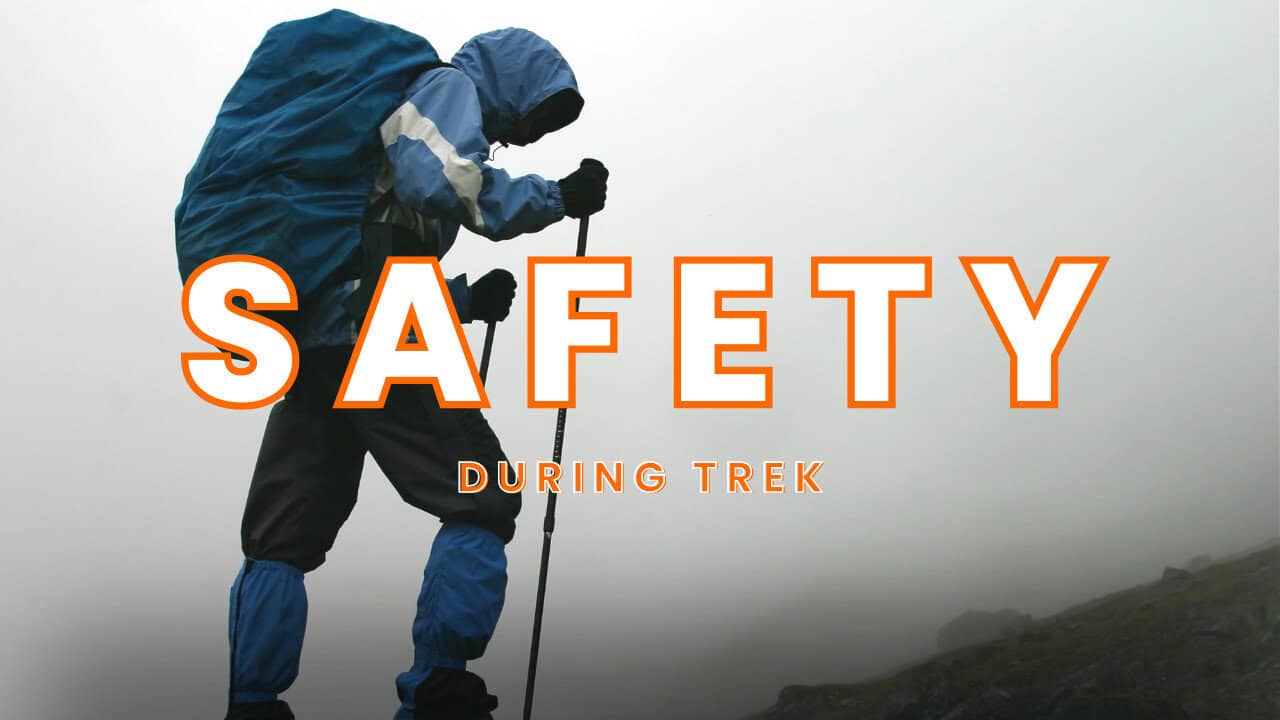
Trekking with us for the Kareri Lake Trek is entirely safe because we have a team of trek leaders qualified in Wilderness first-aid and complete information about the high-altitude glitches. During the trek, we carry a full first-aid kit that contains all the essential medicines. Before trekking with us, you must ensure that you are medically fit for the trek; for us, your medical fitness is more important than anything else.
Right from our establishment, we at Trekup India have been continuously introducing new safety practices into Indian trekking to ensure the safety of voyagers. Trekup India introduced microspikes and made emergency bottled oxygen mandatory for all treks. Our trek leaders take your daily Pulse oximeter reading. We at Trekup India introduced the radio walkie-talkie as a safety communication device.
How can we ensure that your trek is safe with us?
We have noticed that most trek-organizing organizations do not follow these systems, but with time, they are following us; several competing companies are adopting these practices and organizing great, safe treks.
We ensure complete technical safety in the mountain. Our company has a vast team of more than 100 guides and trek leaders who serve on Himalayan treks. One of the best things about our team is that all the members are trained professionally by the Nehru Institute of Mountaineering, Indian Mountaineering Foundation Delhi, and Hanifle Center Outdoor Education Mussoorie.
Explore our New Safety Protocols
To ensure a perfect Trek, we have introduced some new safety checks to ensure excellent safety for our trekkers.
Our On-trek safety checks include:
- Daily oxygen saturation, along with pulse readings
- Stretchers team appointed on every trek
- Radios
- Trained mountain staff and complete safety
- Additional oxygen cylinders
- Special medical kit for high-altitude treks
- Microspikes on all types of snow treks
- Experienced Trek leaders, as well as safety
- Technical team on all snowy slopes
For Us, Your Safety Is the Top Priority
At Trekup India, you will find a team with local knowledge and fluency in English and Hindi. This helps ensure that you have a fantastic trek. Not only this, but we also pay attention to your health and safety because this is something we cannot ignore. All the team leaders involved in trekking have already undergone several professional courses in first aid, portable altitude chamber training, CPR, environmental awareness training, and advanced wilderness emergency medicine.
We also carry a complete first aid medical kit on every trek and trip we organize. Apart from the medical kit, we take a portable altitude chamber (if needed) and medical oxygen for all high-altitude treks. Our company has significant expertise in organizing all sorts of group adventure holidays for family groups, school and college groups, and friend groups. We have many travel options that suit different fitness levels and travelling styles.
Regardless of the group size, we value each and every member of our trekking groups. Our commitment to personal attention ensures that your needs and safety are always our top priority.
Who we are?
Trekup India has been a stalwart in the Adventure Tourism industry for 30 years. Since our inception, we have been dedicated to providing top-notch treks, voyages, trekking programs, and high-altitude expeditions. Our extensive experience is a testament to our commitment to your adventure and safety.
We organize treks in Uttarakhand, Kashmir, Sikkim, and Himachal while being part of the trekking community; we feature more than 75 documented Himalayan treks. In addition to other outdoor activities, our company also organizes trips for schools, colleges, and families.
Therefore, we maintain the quality of services offered to our valuable customers.
Must Read These Information Of Kareri Lake Trek
Why you should do Kareri Lake Trek?
- Flaura and Fauns – The birds that can be identified by their colorful feathers, exotic butterflies, or even adventure lovers might get lucky enough to come across some of those rare species of animals found only in Himalayan highlands are some examples of what might be found along this track which abounds with various kinds of animals. Kareri Lake trek takes you through subtropical pine forests in Himachal Pradesh’s Kangra district. There are chair and chilgoza pines scattered through the forests, along with broad-leaf species. There are pines and shrubs scattered throughout the forest.
- Moderate Challenge – It is possible for trekkers with middle-level fitness because it combines both a good level of physical activity and nice views. For the trek that is not hard and fits both beginners and pros, it is moderately difficult. None of the hikers need to be worried about losing their way since there are enough well-marked trails along the way and no technical climbing skills are demanded so no extreme challenges. Allowing the trekkers to enjoy the journey along with the pristine landscape.
- Glacial Lake – Kareri Lake is fed by the melting snow of The Dhauladhar range, thus becoming a crystal-clear high-altitude lake. Blended with mountains the winter/ glacial lake is a delight to the eye.
- Cultural Immersion – While trekking, one gets a chance to mingle with the local Gaddi shepherds who provide an opportunity to learn about their lifestyle and experience their warm hospitality; an event that makes it an affair that adds a unique dimension to the trekking experience.
- Spiritual Significance – Both Hindus and Sikhs have religious value to Kareri Lake and this offers a unique opportunity to feel the spiritual aura of the Himalayas.
Frequently Asked Questions About Kareri Lake Trek
How to Reach Kareri Lake Trek?
- By Air: The town is so close to Gaggal Airport and which is located at a distance of 18 kilometers. Gaggal is connected to major cities such as Delhi and Chandigarh by regular flights. From the airport, a taxi can be hired to take one to Ghera or Kareri village.
- By Train: The closest major railway station to Kareri Village is located around 85 km from Pathankot. The city of Pathankot is well connected to various Indian cities. From Pathankot, you can catch a taxi or bus to reach Kareri Village.
- By Road: Kareri Village is well-connected by road to major cities in North India. Regular bus services, including Volvo and state-run buses, operate from Delhi, Chandigarh, and other nearby cities. You can also drive to Kareri Village, enjoying the scenic journey through the hills.
What is the Best Time to visit Kareri Lake Trek?
The Dhauladhar range undergoes different seasonal variations, weather, and landscape-wise. The best months for hiking at Kareri Lake are May through June and September through November – before the rains come (pre-monsoon season) and then after they have stopped (post-monsoon season). This is when there’s a little rain, it’s warm enough but not too hot, plus you get awesome views all around. Here’s when you should plan your trek:
- Pre-monsoon (May to June): It’s a great time for trekking because of the relatively warm weather and the rhododendron flowers are blossoming in full color which makes it more scenic due to the vibrant colors they bring about. However, be mindful of any sudden downpours.
- Post-monsoon (September to November): As the monsoon rains fall, the sky is clearing up, and snow-capped peaks are becoming visible since the trails have been washed clean and the environment has become overgrown with vegetation. After the monsoon, there are usually no clouds. This makes it possible for everyone to enjoy the scenic vistas of the Himalayas from a distance. However, because it is quite cold up high, you should bring some warm clothing just in case.


